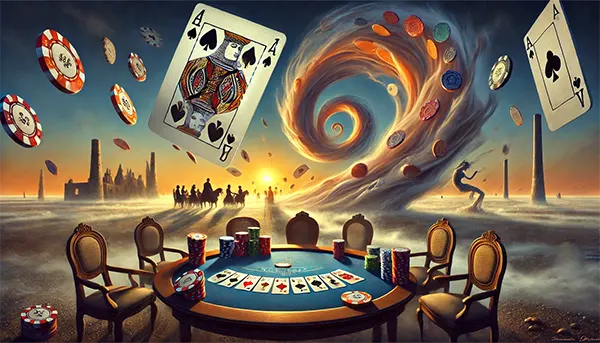
Gambling in Surrealism: The Symbolism of Playing Cards in the Works of Dalí, Magritte, and Others
Surrealist art is known for its dreamlike, illogical, and symbolic imagery, often delving into themes of chance and fate. Gambling motifs, particularly playing cards, chips, and roulette, have been incorporated into surrealist works as metaphors for human existence, unpredictability, and psychological depth. This article explores how surrealists have depicted gambling elements in their artwork, how these images relate to the philosophy of surrealism, and how modern artists continue to explore this theme.
Playing Cards and Casino Symbols in Surrealist Art
Surrealist artists frequently used playing cards, roulette wheels, and dice as symbols of unpredictability and hidden forces shaping reality. These objects appear in works as metaphors for fate, chaos, and the subconscious, aligning with the core principles of surrealism, which sought to depict the irrational and the fantastic.
Salvador Dalí, known for his intricate and symbolic artwork, often depicted playing cards and gambling imagery in his paintings. His series of tarot card illustrations, commissioned in the 1970s, presents archetypal figures in a surreal and enigmatic manner, reflecting his belief in chance and subconscious control over destiny.
René Magritte, another master of surrealism, subtly integrated card games into his art to challenge reality and illusion. His painting “The Lovers” evokes a sense of mystery, much like a game of cards, where the unknown and the unexpected determine the outcome.
The Psychological Interpretation of Gambling in Surrealism
The surrealist movement was heavily influenced by Freudian psychoanalysis, particularly the role of the unconscious in shaping human behaviour. Gambling, with its elements of risk, reward, and unpredictability, serves as a metaphor for the hidden desires and fears lurking in the subconscious mind.
For surrealists, gambling was not merely a game but an act of confronting one’s deepest instincts. The thrill of uncertainty and the surrender to fate mirror the surrealist fascination with dreams, the irrational, and the uncontrollable forces that guide human decisions.
Some interpretations suggest that gambling in surrealist art represents the duality of control and chaos—players believe they influence the game, yet the outcome is dictated by chance, much like the illusion of control in waking life.

Modern Surrealist Works Featuring Gambling Themes
Contemporary artists continue to draw inspiration from the surrealist tradition, incorporating gambling imagery into their work to explore themes of luck, fate, and illusion. Digital artists and surrealist painters of the modern era reinterpret casino symbols in innovative ways, blending classic surrealist aesthetics with modern technological elements.
Artists such as Mark Ryden and Alex Gross create neo-surrealist works that feature playing cards, dice, and roulette wheels as symbols of existential uncertainty and societal constructs. Their art challenges viewers to consider the deeper meaning behind games of chance and their psychological implications.
Additionally, surrealist-inspired casino advertisements and video game designs borrow from the movement’s aesthetic, using dreamlike imagery and distorted perspectives to evoke a sense of mystery and excitement, further proving the lasting influence of surrealism on the gambling industry.
The Cultural Impact of Gambling in Surrealist Art
Beyond individual works, the integration of gambling motifs in surrealist art has influenced popular culture, from film and literature to modern gaming. The notion of chance as a guiding force aligns with the surrealist belief that reality is shaped by subconscious impulses and unexpected events.
Surrealist-inspired casino designs, promotional materials, and themed slot machines highlight the connection between the movement’s artistic approach and the allure of gambling. By combining elements of unpredictability, psychological intrigue, and fantastical imagery, the gambling world continues to pay homage to surrealism.
As long as the human fascination with risk, fate, and illusion persists, surrealist interpretations of gambling will remain a compelling subject, bridging the gap between art, psychology, and the thrill of the unknown.
